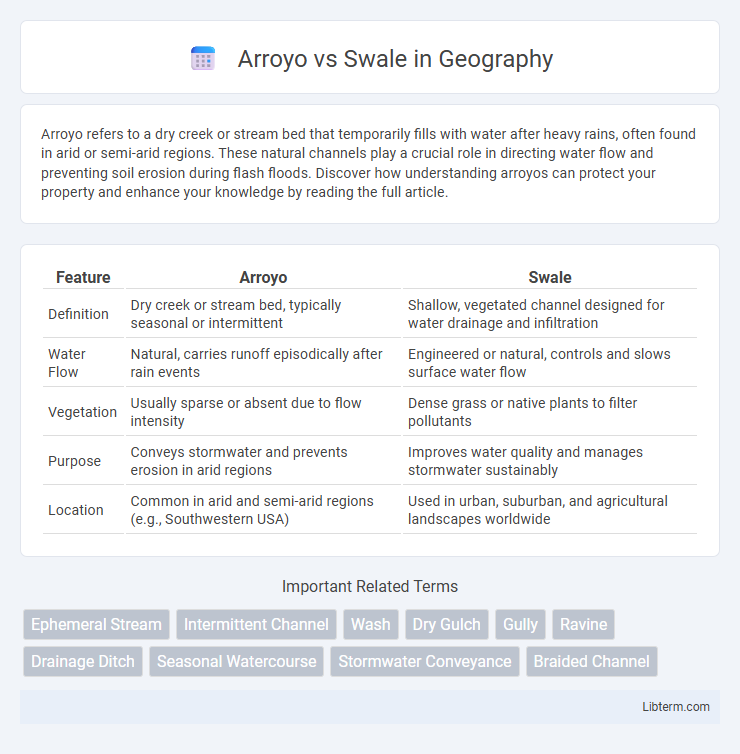Arroyo refers to a dry creek or stream bed that temporarily fills with water after heavy rains, often found in arid or semi-arid regions. These natural channels play a crucial role in directing water flow and preventing soil erosion during flash floods. Discover how understanding arroyos can protect your property and enhance your knowledge by reading the full article.
Table of Comparison
| Feature | Arroyo | Swale |
|---|---|---|
| Definition | Dry creek or stream bed, typically seasonal or intermittent | Shallow, vegetated channel designed for water drainage and infiltration |
| Water Flow | Natural, carries runoff episodically after rain events | Engineered or natural, controls and slows surface water flow |
| Vegetation | Usually sparse or absent due to flow intensity | Dense grass or native plants to filter pollutants |
| Purpose | Conveys stormwater and prevents erosion in arid regions | Improves water quality and manages stormwater sustainably |
| Location | Common in arid and semi-arid regions (e.g., Southwestern USA) | Used in urban, suburban, and agricultural landscapes worldwide |
Introduction to Arroyo and Swale
An arroyo is a dry creek or stream bed that temporarily fills with water after heavy rain, commonly found in arid or semi-arid regions. A swale, in contrast, is a shallow, vegetated channel designed to manage stormwater runoff by promoting infiltration and reducing erosion. Both arroyos and swales play critical roles in natural and engineered water drainage systems.
Defining Arroyo: Key Features
An arroyo is a dry creek or stream bed that temporarily fills and flows with water after heavy rains, characterized by steep banks and a typically sandy or rocky bottom. These seasonal watercourses are common in arid and semi-arid regions, playing a crucial role in drainage and sediment transport. Unlike permanent rivers, arroyos exhibit intermittent flow patterns, often leading to flash flooding during intense precipitation events.
Understanding Swale: Characteristics and Functions
A swale is a shallow, vegetated channel designed to manage water runoff, reduce erosion, and promote infiltration, distinguishing it from a naturally formed arroyo, which is typically a dry creek bed that fills rapidly during heavy rain. Characterized by its gentle slope and wide, flat bottom, a swale slows water flow to encourage filtration and groundwater recharge, often integrated into sustainable urban drainage systems. Native plants and grasses within swales enhance sediment capture and nutrient absorption, making them vital for effective stormwater management and erosion control.
Formation Processes: Arroyo vs Swale
Arroyos form primarily through intense episodic water flow that causes deep channel erosion in arid or semi-arid regions, often featuring steep, incised banks. Swales develop as low-lying, shallow depressions formed by soil subsidence, accumulation of organic material, or gentle surface water runoff, promoting moisture retention and vegetation growth. While arroyos reflect active erosional dynamics, swales typically represent depositional landscapes with minimal soil disturbance.
Ecological Roles and Environmental Impact
Arroyos and swales both serve critical ecological roles by managing water flow and supporting biodiversity in their respective environments. Arroyos, typically dry creek beds that fill during rainfall, help channel stormwater runoff and reduce erosion in arid regions, while promoting native vegetation growth along their banks. Swales, shallow vegetated channels designed for water infiltration, improve groundwater recharge, filter pollutants from urban runoff, and create habitats for amphibians and pollinators, thereby enhancing ecosystem services and water quality in urban landscapes.
Common Locations and Occurrences
Arroyos commonly occur in arid and semi-arid regions such as the southwestern United States and northern Mexico, where intermittent water flow carves deep, dry creek beds. Swales are frequently found in both natural landscapes and urban environments, often appearing as shallow, linear depressions in wetlands, grasslands, or designed stormwater management areas. Both features serve as important channels for water movement, with arroyos typically associated with rapid flow during flash floods and swales facilitating slower drainage and infiltration.
Hydrology: Water Flow Dynamics
Arroyo and swale exhibit distinct hydrological characteristics influencing water flow dynamics in watersheds. Arroyos, typically dry creek beds or gulches, convey intermittent or ephemeral surface runoff rapidly during storm events, shaping erosion and sediment transport patterns. Swales function as shallow, vegetated channels that slow water movement, promote infiltration, and reduce surface runoff peaks, enhancing groundwater recharge and mitigating flood impacts.
Erosion and Sediment Transport Differences
Arroyos are typically steep-sided, ephemeral channels characterized by rapid water flow that causes significant erosion and sediment transport during flash flood events. Swales are shallow, broad depressions with gentle slopes that promote slow-moving water, reducing erosion but allowing sediment deposition and infiltration. The steep gradients and concentrated flows in arroyos result in higher sediment yield and channel incision compared to the low-energy, sediment-trapping environment of swales.
Applications in Landscape Design and Water Management
An arroyo is a dry creek or stream bed that temporarily fills with water after heavy rain, often used in landscape design to create naturalistic drainage features that manage stormwater runoff effectively. Swales are shallow, vegetated channels designed to slow, capture, and infiltrate rainwater, improving groundwater recharge and reducing erosion in urban and rural landscapes. Both arroyos and swales play critical roles in sustainable water management by controlling surface water flow, enhancing soil moisture retention, and preventing flood damage.
Choosing Between Arroyo and Swale: Practical Considerations
Choosing between an arroyo and a swale depends on specific site conditions such as soil permeability, drainage needs, and vegetation type. Arroyos effectively manage flash floodwaters and sediment transport typical in arid regions, while swales provide shallow, vegetated channels ideal for stormwater infiltration and surface runoff control in urban or suburban landscapes. Evaluating factors like climate, land use, and maintenance requirements ensures the most efficient, sustainable water management solution.
Arroyo Infographic

 libterm.com
libterm.com